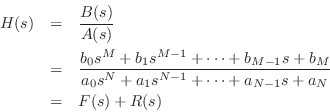Partial Fraction Expansion: residuez.m
Figure J.8 gives a listing of a matlab function for computing
a ``left-justified'' partial fraction expansion (PFE) of an IIR
digital filter
![]() as described in §6.8 (and
below). This function, along with its ``right justified''
counterpart, residued, are included in the
octave-forge matlab library for Octave.J.1
as described in §6.8 (and
below). This function, along with its ``right justified''
counterpart, residued, are included in the
octave-forge matlab library for Octave.J.1
function [r, p, f, m] = residuez(B, A, tol) if nargin<3, tol=0.001; end NUM = B(:)'; DEN = A(:)'; % Matlab's residue does not return m (implied by p): [r,p,f,m]=residue(conj(fliplr(NUM)),conj(fliplr(DEN)),tol); p = 1 ./ p; r = r .* ((-p) .^m); if f, f = conj(fliplr(f)); end |
This code was written for Octave, but it also runs in Matlab if the 'm' outputs (pole multiplicity counts) are omitted (two places). The input arguments are compatible with the existing residuez function in the Matlab Signal Processing Toolbox.
Method
As can be seen from the code listing, this implementation of
residuez simply calls residue, which was written to
carry out the partial fraction expansions of ![]() -plane
(continuous-time) transfer functions
-plane
(continuous-time) transfer functions ![]() :
:

where ![]() is the ``quotient'' and
is the ``quotient'' and ![]() is the ``remainder'' in the PFE:
is the ``remainder'' in the PFE:
where
In the discrete-time case, we have the ![]() -plane transfer function
-plane transfer function
For compatibility with Matlab's residuez, we need a PFE of the form

where ![]() .
.
We see that the ![]() -plane case formally does what we desire if we
treat
-plane case formally does what we desire if we
treat ![]() -plane polynomials as polynomials in
-plane polynomials as polynomials in ![]() instead of
instead of
![]() . From Eq.
. From Eq.![]() (J.2), we see that this requires reversing the
coefficient-order of B and A in the call to
residue. In the returned result, we obtain terms such as
(J.2), we see that this requires reversing the
coefficient-order of B and A in the call to
residue. In the returned result, we obtain terms such as

Example with Repeated Poles
The following Matlab code performs a partial fraction expansion of a filter having three pairs of repeated roots (one real and two complex):J.2
N = 1000; % number of time samples to compute A = [ 1 0 0 1 0 0 0.25]; B = [ 1 0 0 0 0 0 0]; % Compute "trusted" impulse response: h_tdl = filter(B, A, [1 zeros(1, N-1)]); % Compute partial fraction expansion (PFE): [R,P,K] = residuez(B, A); % PFE impulse response: n = [0:N-1]; h_pfe = zeros(1,N); for i = 1:size(R) % repeated roots are not detected exactly: if i>1 && abs(P(i)-P(i-1))<1E-7 h_pfe = h_pfe + (R(i) * (n+1) .* P(i).^n); disp(sprintf('Pole %d is a repeat of pole %d',i,i-1)); % if i>2 && abs(P(i)-P(i-2))<1E-7 ... else h_pfe = h_pfe + (R(i) * P(i).^n); end end err = abs(max(h_pfe-h_tdl)) % should be about 5E-8
Next Section:
Partial Fraction Expansion: residued.m
Previous Section:
Frequency Response Plots: plotfr.m




















